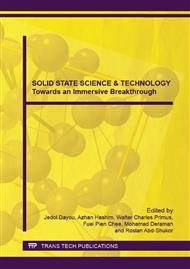p.38
p.45
p.53
p.59
p.67
p.73
p.79
p.85
p.91
Catalytic CO2/H2 Methanation Reaction over Alumina Supported Manganese/Cerium Oxide Based Catalysts
Abstract:
The methanation reaction is a promising method for the purification of natural gas, in which the acid gases of CO2, is eliminated by catalytic conversion. The advantage of catalytic technology is the utilization of CO2 present in the production of methane gas. The used of alumina supported cerium oxide as the based catalyst in CO2/H2 methanation reaction have been investigated in this research by using manganese as the dopant and ruthenium as the co-dopant via wet impregnation technique. The series of cerium oxide catalysts were calcined at 400 °C for 5 hours had been prepared at the screening stage. Then, the catalysts were optimized by different calcination temperatures and different based oxide loadings. The potential catalysts of Ru/Mn/Ce (5:35:60)/Al2O3 calcined at 700 °C gave 100 % of CO2 conversion by using FTIR and yielded about 24 % of CH4 respectively at reaction temperature of 400 °C. X-ray Diffraction (XRD) and Field Emission Scanning Electron Microscope (FESEM) showed that the supported catalysts were amorphous in structure. FESEM analysis illustrated the surface of the catalysts were covered with small and dispersed spherical particles. EDX analysis revealed that there was 1.02 % reduction of Ru in the Ru/Mn/Ce (5:35:60)/Al2O3 used catalysts compared to fresh catalysts. Meanwhile NA analysis showed that Ru/Mn/Ce (5:35:60)/Al2O3 catalysts attained surface area of 143.10 m2/g respectively.
Info:
Periodical:
Pages:
67-72
Citation:
Online since:
June 2015
Keywords:
Price:
Сopyright:
© 2015 Trans Tech Publications Ltd. All Rights Reserved
Share:
Citation:


